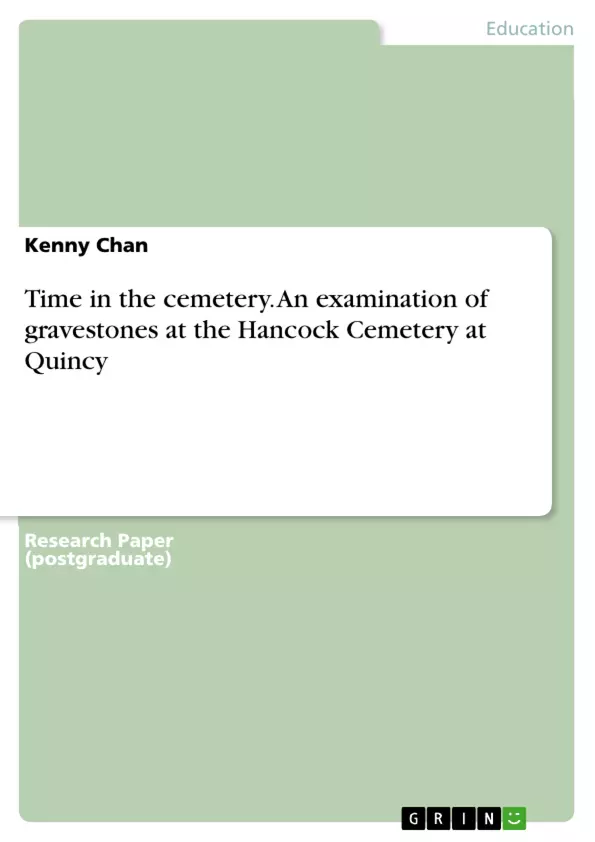The following work presents the results of a research of grave stones in the Hancock Cemetery at Quincy, Norfolk County, Massachusetts. The city of Quincy is already known for its historical backgrounds especially since it was the birth place of two former Presidents, John Adams and John Quincy Adams. Not only is Quincy their birth place but it is also where they were put to rest. A nickname for the city of Quincy is “The city of President”. The cemetery was incorporated in 1640 and was the only burial place until 1716 when additional cemeteries were added. The Hancock Cemetery then became the designated cemetery for the North Precinct of Braintree and the Town of Quincy. Around 1844 more land was purchased allowing more burial ground for the Hancock Cemetery. This cemetery was Quincy’s main cemetery until 1854, when they opened the Mount Wollaston Cemetery (Interment).
The main subject of this work is the examination of the grave stones concerning their motifs and stone types.
Inhaltsverzeichnis (Table of Contents)
- Time in the Cemetery
- The Hancock Cemetery
- Headstone Motifs
- Hypothesis: Children's Headstone Motifs
- Analyzing the Data
- Headstone Material and Condition
- Motifs and The Great Awakening
- Conclusion
Zielsetzung und Themenschwerpunkte (Objectives and Key Themes)
The study aims to explore the relationship between headstone motifs and social significance in the Hancock Cemetery in Quincy, Massachusetts. By analyzing the design, materials, and condition of headstones, the author seeks to understand how societal values and perceptions of death were reflected in burial practices during the colonial period.
- Headstone Motifs and Symbolic Meanings
- Social Significance of Children in Colonial Society
- The Influence of Material and Condition on Headstone Longevity
- The Impact of Religious Shifts on Cemetery Design
- The Evolution of Burial Practices over Time
Zusammenfassung der Kapitel (Chapter Summaries)
- The study begins by introducing the Hancock Cemetery, its historical significance, and the methodology used to collect data. The author focuses on headstones with similar motifs, particularly those with cherubs, and the surname Beale, which appears frequently in the data.
- The author develops a hypothesis that children's headstones might lack designs due to their perceived lower social significance compared to adults. They collect data to test this hypothesis, analyzing the presence or absence of motifs on headstones of both children and adults.
- The analysis of the data reveals that the hypothesis is not supported. While the size of children's headstones tends to be smaller, they often feature designs similar to those found on adult headstones, suggesting children were not necessarily seen as less important in society.
- The study explores the connection between headstone material (granite and slate) and their condition. The author finds that granite headstones tend to be in better condition than those made of slate, suggesting that granite is more durable and resistant to environmental factors.
- The author examines the shift in headstone motifs from cherubs to urn-and-willow designs, linking this change to the end of the Great Awakening and a shift in religious views. While the data supports the general trend, there are exceptions, highlighting the complexities of cultural change and the persistence of traditional practices.
Schlüsselwörter (Keywords)
The study focuses on a number of key themes, including colonial burial practices, headstone symbolism, social significance of children, materiality and longevity of headstones, and the impact of religious shifts on cemetery design.
- Quote paper
- Kenny Chan (Author), 2010, Time in the cemetery. An examination of gravestones at the Hancock Cemetery at Quincy, Munich, GRIN Verlag, https://www.grin.com/document/276725



